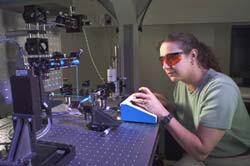Microscopes provide new view for tissue engineering

NIST physical scientist Joy Dunkers positions a polymer scaffold sample for imaging. <br>©Robert Rathe
In the November issue of Optics Express*, National Institute of Standards and Technology (NIST) scientists describe a novel combination of microscopes that can peer deep into tissue-engineering scaffolds and monitor the growth and differentiation of cells ultimately intended to develop into implantable organs or other body-part replacements.
The new dual-imaging tool provides a much needed capability for the emerging tissue engineering field, which aims to regenerate form and function in damaged or diseased tissues and organs. Until now, scrutiny of this complicated, three-dimensional process has been limited to the top-most layers of the scaffolds used to coax and sustain cell development.
Composed of biodegradable polymers or other building materials, scaffolds are seeded with cells that grow, multiply, and assemble into three-dimensional tissues. Whether the cells respond and organize as intended in this synthetic environment depends greatly on the composition, properties, and architecture of the scaffolds’ porous interiors. Tools for simultaneously monitoring microstructure and cellular activity can help scientists to tease apart the essentials of this interactive relationship. In turn, such knowledge can speed development of tissue-engineered products ranging from skin replacements to substitute livers to inside-the-body treatments of osteoporosis.
NIST scientist Joy Dunkers and her colleagues paired an optical coherence microscope – a high-resolution probe of the scaffold interior – with a confocal fluorescence microscope – used to track cells stained with a fluorescent dye. The instruments provide simultaneous images that can be merged to create a comprehensive rendering of microstructure and cellular activity. By stacking the sectional images, they can create a top-to-bottom movie showing structural and cellular details throughout the scaffold’s volume.
*J. P. Dunkers, M. T. Cicerone, and N. R. Washburn, “Collinear optical coherence and confocal fluorescence microscopies for tissue engineering,” Optics Express, Vol. 11, No. 23, pp. 3074-3079. [http://www.opticsexpress.org].
Media Contact
All latest news from the category: Physics and Astronomy
This area deals with the fundamental laws and building blocks of nature and how they interact, the properties and the behavior of matter, and research into space and time and their structures.
innovations-report provides in-depth reports and articles on subjects such as astrophysics, laser technologies, nuclear, quantum, particle and solid-state physics, nanotechnologies, planetary research and findings (Mars, Venus) and developments related to the Hubble Telescope.
Newest articles

“Nanostitches” enable lighter and tougher composite materials
In research that may lead to next-generation airplanes and spacecraft, MIT engineers used carbon nanotubes to prevent cracking in multilayered composites. To save on fuel and reduce aircraft emissions, engineers…

Trash to treasure
Researchers turn metal waste into catalyst for hydrogen. Scientists have found a way to transform metal waste into a highly efficient catalyst to make hydrogen from water, a discovery that…

Real-time detection of infectious disease viruses
… by searching for molecular fingerprinting. A research team consisting of Professor Kyoung-Duck Park and Taeyoung Moon and Huitae Joo, PhD candidates, from the Department of Physics at Pohang University…





















